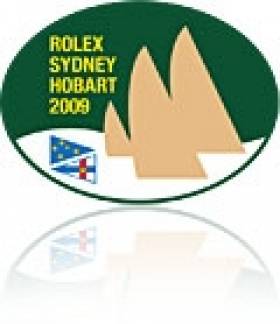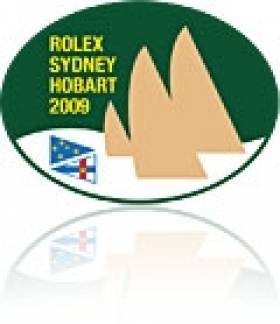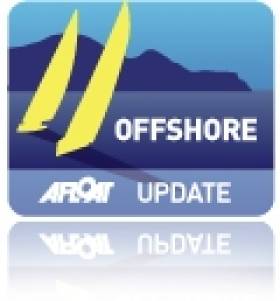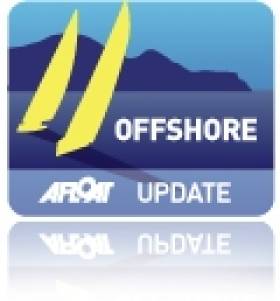Displaying items by tag: sydneyhobart
Wild Oats XI Does It Again in Sydney–Hobart Race
#rshyr – Veteran owner Bob Oatley's Reichel Pugh 100 Wild Oats XI, skippered by Mark Richards, has taken her seventh line honours win in the Rolex Sydney Hobart Race, with an evening finish at Hobart at 19.07.27 hrs AEDT writes W M Nixon.
Up-dating our report from last night's midnight posting of Sailing on Saturday, the slim hulled fleet leader continued to build on her light airs lead over Anthony Bell's much beamier hundred footer Perpetual LOYAL, the former Rambler 100. The gap between the two became even greater when Wild Oats began to feel the benefits of a building nor'easter the further south she got, while Perpetual was virtually becalmed.
Thus the gap expanded to more than fifty miles. But then as Perpetual began to feel the breeze, she showed her potential and was zooming down the Tasmanian coast at speeds of up to 28.2 knots, closing the gap to 25 miles. However, by this time Wild Oats was shaping her way into the Derwent estuary and the often tricky final virtually inland stages to the finish. She was comfortably across the line in mid-evening in an easing breeze which had her speed down to 9-11 knots, though at one stage while in Storm Bay the power in the new nor'easter had her down to storm jib and heavily reefed main.
But as darkness closes in, the wind has gone in the Derwent, and while Perpetual LOYAL has only 18 miles to the finish, her current speed of 3 knots could make it a long and frustrating night, and though she has a lower rating than Wild Oats, it looks unlikely she'll beat her on handicap. But for now Wild Oats XI is the undisputed 2013 holder of the prestigious Illingworth Cup for first to finish, named in honours of the noted English offshore racing skipper Captain John Illingworth who, in 1945, suggested that a proposed post-Christmas cruise-in-company from Sydney to Hobart should be sailed as a race instead. He won it too, and the rest is history.
Now with the Tasmanian weather into a more volatile state, all sorts of possibilities arise for the new holder of the Tattersall's Cup for the overall winner under IRC. Wild Oats did the double in 2012, but under current placings and speed of those still racing at 1000 hrs Irish time, she lies at 69th overall, while the leader is Bruce Taylor's Reichel Pugh 40 Chutzpah.
Second place is currently held by the Farr 43 Wild Rose owned by Roger Hickman, which back in the day was the original Wild Oats, so it would make for a nice double if she could pick up that extra place on handicap.
Of boats of Irish interest, the First 40 Breakthrough, skippered by Barry Hurley of the Royal Irish YC, was at one stage third on handicap overall, but has currently slipped to 31st overall, which shows just how rapidly things can change. My apologies, by the way, to the two Irish owners of First 40s, one in Baltimore and the other based on the Algarve, for saying that we don't have any of these fine boats in the Irish fleet – as you'll gather, I've been very quickly put right on that one.
The Clipper 70 Derry-Londonderry-Doire skippered by Sean McCarter of Lough Swilly lies 42nd overall on IRC, but is first of the 12-strong Clipper fleet, so keep an eye on that, and keep fingers crossed too. Ich Ban with Gordon Maguire on the helm was 36th OA, but might get lucky in the final stages. It may be complex in the extreme, with the time lapse adding o the confusion, but this is turning out to be one specially fascinating Rolex Sydney-Hobart Race.
Sydney–Hobart Race: Breakthrough Under Radar is a Beau Geste
#rshyr – It is developing into one of the most complex Rolex Sydney-Hobart Races sailed in many a long day. And as it's in the upside-down Southern Hemisphere, weatherwise everything moves in different ways. W M Nixon isn't sure he has a clue what's going on, but he happily throws in his pennyworth to add to the confusion.
One surefire way to get publicity is to keep things secret, just releasing tasty bits of info at the last minute. With the Rolex Sydney-Hobart Race providing a focal point of sailing attention at a time when most of the world is being distracted by minor matters such as celebrating Christmas, or simply getting through midwinter storms, the opportunities to make a show-stopping impact are magnified.
A dearth of maritime stories at home makes the saltheads leap at anything of cheerful sailing interest. For there are only so many ways that you can report that ferries aren't sailing at all, or are delayed. If we never hear the phrase "operational reasons" again, it will be too soon. And sad and all as we are about the huge whale in Achill, we were too far away to do anything about it. But give us something like the sudden appearance of Karl Kwok's startling new 80ft Beau Geste in Sydney just a couple of days before the race to Hobart begins, or the news on Christmas Day that a First 40 formerly thought of as just another Australian boat is actually an Irish entry in disguise and slipped in under the radar, then we come to life.
Naturally there'd been plenty of stories circulating about the new Kwok boat. However, as the other serious biggies in the Hobart fleet began to strut their stuff around Sydney harbour through December, inevitably they hovered up the attention. But then on Sunday, out of the blue, Beau Geste sailed into Sydney after a crisp and very satisfying four day test passage across from New Zealand, which is cooking with gas
.
Anybody mind if we come in? The brand new 80ft Beau Geste arrives in Sydney on December 22nd after her speedy maiden voyage from New Zealand. Photo: Rolex/Carlo Borlenghi
You can understand the reluctance of skipper Gavin Brady and the rest of Karl Kwok's team to seek the limelight. The previous much-admired Farr-designed 80ft Beau Geste, winner of many trophies, had suddenly as near as dammit broken in two off Norfolk Island during the 2012 Auckland-Noumea Race. The good folk of Norfolk Island did their best to help out, as did ships and fishing boats in the neighbourhood, but to this day nobody is too sure how the big boat stayed afloat long enough to be got to port.
There they were, all the gear intact, but the hull a write-off. They say that when you're unhorsed you should get back in the saddle immediately if the horse isn't injured. But this was one terminally injured nag. So they did the next best thing. They went to designer Mareclino Botin, he who created the Volvo 70 Camper which was the most radically different of the generally similar Volvo flotilla last time round, and ordered up a new canting keel 80 footer with debut planned for the 2013 Sydney-Hobart Race.
Built by Cookson in Auckland with beefed up engineering by comparison with the previous boat, but carrying some of her gear, the new boat is of interest every which way, as Botin used to be in partnership with Shaun Carkeek, who has designed the much-fancied 60-footer Ichi Ban for Matt Allen. And you can see (or maybe imagine) certain distant style resemblances between the two boats. But as the new Kwok boat follows Botin's enthusiasm for having the mast well aft (it was so far aft in Camper it was astern of the canting keel), it wouldn't be an exaggeration to describe Beau Geste as a one-masted schooner, though no more so than Volvo 70s like Giacomo.
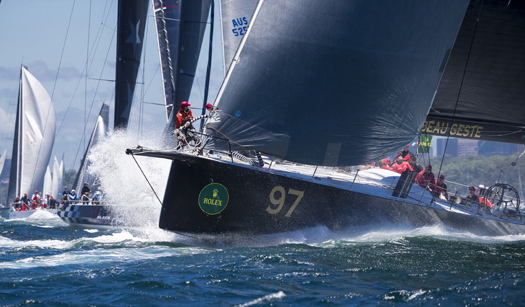
Baptism of fire. The Sydney-Hobart 2013 is Beau Geste's first race – she'd barely been afloat for a month when it started on Thursday. Photo: Rolex/Daniel Forster
Nevertheless, the first time this slightly offbeat boat had a crack at the opposition was in that initial crazy eight minute drag race down Sydney harbour at the start of the race to Hobart on Thursday. Of which more anon. But meanwhile, what's this about an Irish entry disguised as a bog standard Australian one?
Well, they sprang it on us all with perfect timing on Christmas morning. There in the entry list is Breakthrough, a First 40, a boat type always of high interest - when the design was new, back in 2010, two of them took first and second overall in the Rolex Sydney-Hobart Race.
It was a marketing dream for Beneteau, for each race to Hobart will always produce a particular set of conditions which will suit one boat type to a T. In 2010, it was the very new First 40 which hit the spot, coming forward to step into the very big shoes so capably filled for years by the marvellous First 40.7.
They may have got everything right, but circumstances conspired against the new First 40 being a runaway marketing success. Primarily, it was the global recession taking hold big time, particularly in Europe. But then too, there was still plenty of life in the First 40.7, with thriving class associations, and one design racing in events like Cowes Week.
Whatever, we've only seen two First 40s in Irish ownership since the design appeared, one in Baltimore and used for cruising, the other based in the Algarve. But now the good news is that Barry Hurley is actually the skipper of Breakthrough on the race to Hobart. It must be true, as you read it here on Afloat.ie on Christmas morning while talking to that fat white-bearded man in the red suit.....But enough. Even if the official CYCA listing suggests Mathew Vadas is the skipper, man in charge is Barry Hurley, already with two Hobart races notched, and with him he has brought Kenny Rumball, Keith Kiernan and Catherine Halpin, all of the Royal Irish YC, to sail in partnership with the Vadas team, and hoping to repeat that Hurley touch which brought a class win in the Middle Sea Race back in October.
As for the big boat start – well, it was eight minutes like we'd never seen before. Morning clouds had cleared to leave Sydney Harbour at its sparkling best in a brisk sou'easter, reaching start to the first mark, and the biggies went off first at max revs with Wild Oats and Perpetual LOYAL neck and neck for the lead, with Anthony Bell's Perpetual in the weather gauge.

The power of Perpetual LOYAL's hull is plain to see – but that power with its extensive wetted area comes at the expense of light weather performance. Photo: Rolex/Daniel Forster
But the "old" Wild Oats never ceases to surprise, or maybe Mark Richards and his crew know her so well that they can hit top performance while others are still winding up to it. They simply held Perpetual up above the line to the first mark until they were able to peel away for a short run to the turn which left enough of a gap between them and the big black boat to allow Beau Geste to nip in between in second place.
The abiding memory of that eight minute sprint was the way the different boats had sudden bursts of acceleration. You'd to keep reminding yourself that the smallest craft in this flotilla were 70ft Volvos, for all were having speed bursts like dinghies on the plane.
So that was interesting, but then as they started the beat south in open water, it became clear that Wild Oats with a reef in the main was holding on very nicely ahead of the supposedly more powerful Perpetual, while the smaller Beau Geste was sagging to lee. But then, schooners never could point high, whereas Wild Oats' pointing ability in a lumpy sea was a wonder to behold.
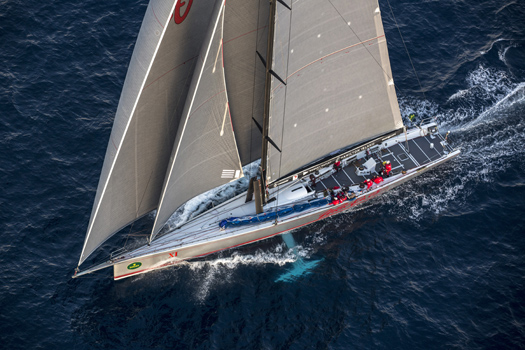
The skinny one....thanks to her slim hull, in the light airs on Day 2 Wild Oats was able to re-take the lead from Perpetual LOYAL. Photo: Rolex/Carlo Borlenghi
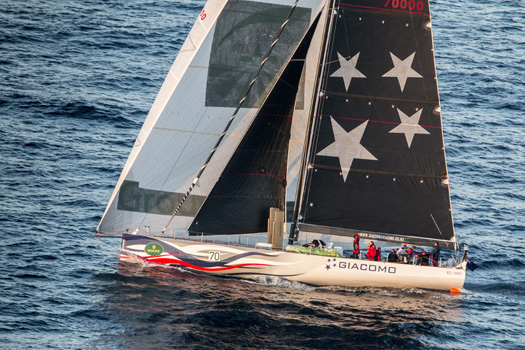
The Volvo 70s may have been developed for big winds in open water, but the former Groupama, now racing for New Zealand as Giacomo, has shown she can hang in when the breezes are light. Photo: Rolex/Carlo Borlenghi
Through the first night, the wind went light, and things were further turned on their head by ace navigator Stan Honey taking Perpetual LOYAL well to the east, which did her a lot of good. By morning they'd worked out an eleven mile lead on Wild Oats, but through the second day of light winds, Wild Oats ground down the big black boat, and as they crossed Bass Strait yesterday evening it was the old dog for the long road, Wild Oats still in the lead and hoping to have the advantage of an afternoon/evening arrival up the Derwent to Hobart before tonight's freshening northerly is replaced by southwest to west winds which could reach gale force, stacking the odds against the little fellows.
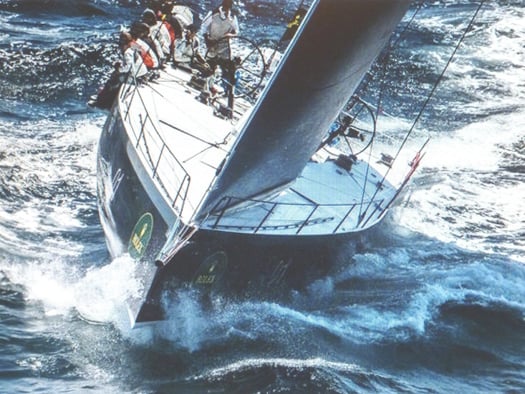
By comparison with some of the boat shapes racing to Hobart, Matt Allen's 60ft Ichi Ban with Gordon Maguire on the helm looks almost traditional. Photo: Rolex/Carlo Borlenghi
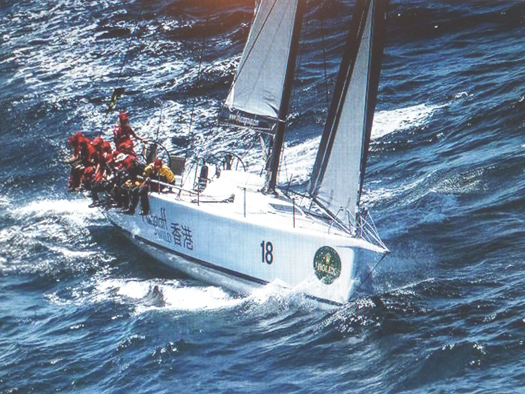
With the renowned Adrienne Cahalan as navigator, the 55ft Wedgetail is in with a shout. Photo: Rolex/Carlo Borlenghi
But meanwhile the top Irish hope, Gordon Maguire with Matt Allen's 60ft Ichi Ban , has been hanging in very nicely and things could fall sweetly their way. That said, while the 60ft Ichi Ban has been staying on the tails of the big boats ahead, not so far astern is the next size group with the lead held by Bill Wild's Reichel Pugh 55 Wedgetail. Formerly Yendys, this is one of Australia's proven all rounders. And for this first race to Hobart under the Wild command, Wedgetail's navigator is Adrienne Cahalan, who is renowned for seeing skippers on to the Hobart podium. But then, she was born in Offaly, and that makes all things possible.
Irish Sailors in the Mix as Light Air Sydney-Hobart Passes Half Way Stage
#rshyc – Irish offshore sailors are in the leading pack of the Sydney-Hobart race today but lack of breeze is leading to tense decisions as Dun Laoghaire sailors onboard the 'Dun Laoghaire entry' Breakthrough, a Beneteau 40 skipered by Barry Hurley, lie sixth overall on IRC handicap. Howth's Gordon Maguire is eighth on Ichi Ban that is chasing for line honours and Adrienne Cahalan a navigator with strong Irish connections, sailing in her 22nd race is 46th on IRC. The Clipper yacht entry Derry-London Derry skippered by Sean McCarter is 65th on IRC in the 92 boat fleet. Live race tracker here.
Twenty-four hours after the Rolex Sydney Hobart fleet raced out of Sydney Harbour the pace slowed up as the lead boats picked their way down the southeast coast of Australia.
Also on board Breakthrough is Irish Fireball champion Kenny Rumball, (Watch Leader), Keith Kiernan (Navigator & Radio man), Catherine Halpin (Bow-Woman) all members of the Royal Irish Yacht Club.
Meanwhile, a navigator with strong Irish connections, Adrienne Cahalan is sailing in her 22nd race – but after eight years on the 100-foot Wild Oats XI, the accomplished offshore navigator is shifting gears and stepped onto a boat close to half the size: Bill Wild's 55-footer, Wedgetail.
This morning Cahalan emailed, "It was busy last night – lots of sail changes as we headed south through clouds coming from shore. We were in close contact all night with Ichi Ban, Varuna, Nikata, Victoire and Zefiro.
"The wind is so light out here now that if you did not position your boat last night for today, it is probably too late now. Having said that the fleet is close together today near us and appear to be following the same strategy, unlike last night when some boats when right inshore and some, like us, chose to stay further offshore. The wind won't fill in from the north until later today for us, so we are patiently waiting."
Overnight, Anthony Bell's Perpetual Loyal made the strategic move to head further offshore than her main rival, Bob Oatley's six-time line honours winner, Wild Oats XI. Loyal's strategy worked as they eked out a gain of close to 14 nautical miles, surprising given pre-race the boat was touted as favouring heavier airs.
By midday today (December 27) however, Wild Oats XI reeled in Loyal and took a slight lead. Just ten miles back was Syd Fischer, sailing in his 45th Sydney Hobart, this time on Ragamuffin 100, newly fitted out with water ballast and daggerboards – and as of this afternoon, leading IRC Division Zero on handicap.
The weather forecast will be the game changer for all of the fleet as they sail down the coast. Rachel McInerney, Duty Forecaster for the Bureau of Meteorology in Hobart reported earlier today, "Currently through Bass Strait there are light southwesterly winds, which will weaken as a ridge of high pressure west of Tasmania moves east. Winds will become light and variable overnight and then a north-northeasterly flow will develop through tomorrow morning; this will freshen the further down the east coast they go.
"Expecting northeast winds to become strong Saturday afternoon (Dec 28), 20-30 knots along lower east coast (15-25 upper east coast). A westerly change is expected Saturday evening which could cause some issues with winds turning around west-southwest, quite strong, up to gale-force along the south coast."
Approximately 80 nautical miles behind Wild Oats XI, is Matt Allen's Carkeek 60, Ichi Ban, currently leading IRC Division 1 on handicap. Helmsman on board Ichi Ban is Howth's Gordon Maguire. Will Oxley, navigator onboard, reported earlier, "We're just hanging on the coat tails of some of the big boats. Looks like a tricky day, and we are hoping to hold onto favourable northeast winds as long as possible. All is going to game plan, except for thunderstorms inshore last night, which slowed the fleet a bit."
Adrienne Cahalanis sailing in her 22nd race – but after eight years on the 100-foot Wild Oats XI, the accomplished offshore navigator is shifting gears and stepped onto a boat close to half the size: Bill Wild's 55-footer, Wedgetail.
As of 4:00pm AEDT, the bulk of the fleet was between Eden and Uladulla, almost all boats east of the rhumbline, up to 70 nautical miles offshore.
As the frontrunners entered Bass Strait mid-afternoon today they were sailing in a light southwesterly making less than 10 knots of boat speed, in four knots of wind. With the race record for line honours no longer in threat, the ETA for the big boats at the finish off Hobart is more likely Saturday evening. Nonetheless, with 300+ nautical miles to the go, the battle is far from over. The lack of breeze is frustrating and challenging. Anthony Bell, skipper of Perpetual Loyal said, via Skype this afternoon, "Don't know if you want to be the frontrunner going into Tasman Island; as long as we stay in touch and stay within striking distance...we're staying positive, and the guys are working hard to keep the boat going."
Ninety-two boats are still racing, with two boats retired shortly after the start yesterday; Audi Sunshine Coast with damage to her rig, and Dodo with mainsail damage.
Royal Irish Yacht Club Sailors Racing in Sydney–Hobart
#rshyr– Christmas Day has come to a close on the other side of the world and for a few Irish sailors it means the last night of comfortable sleep as they are now racing in the Rolex Sydney to Hobart Race.The Irish crew consists of Barry Hurley (Skipper), Kenneth Rumball (Watch Leader), Keith Kiernan (Navigator & Radio man), Catherine Halpin (Bow-Woman) all coincidentally members of the Royal Irish Yacht Club in Dun Laoghaire. Racing on the Australian Beneteau First 40 entry, 'Breakthrough', the crew began racing this morning (26th of December) from a start inside the heads of Sydney Harbour. Race tracker here.
It's Christmas – Time to Race Big Boats to Hobart
The Rolex Sydney-Hobart Race would be a great event at any time. But the annual staging of this 628-mile challenge when much of the Northern Hemisphere is lying low under the effects of mid-winter celebrations provides welcome entertainment and interest for sailors worldwide. The 69th Sydney-Hobart starts next Thursday, December 26th. W M Nixon sets the scene, and highlights Irish interest
Australia is a very large land mass packed tight with valuable metals and minerals of all kinds. With each advance in mining technology, the country's huge natural wealth is more easily accessed, and the general affluence of the relatively small population increases even further.
Thus while much of the rest of the world has been experiencing economic turmoil and recession for the past five years, in Australia it was only a distant rumour. And though the challenge of mining Australia's resources may be a tough business, dominated by some very rough diamonds, all round the coast of this sparsely populated continent there are civilised enclaves of sea-minded folk who live a very agreeable life remote from the harsh realities of industrial mining.
So when they go sailing, they do so in some style in their usually sunny climate. If they compete afloat, it's with all the exuberance of a sports-mad nation with a largely outdoor way of life. And when they compete at the top level, it's increasingly a no-expenses-spared business which leaves much of the rest of the penny-pinching world floundering in their wake.
Australian sailing is on a roll which is really only just getting going. Two of the key people in the three man afterguard of the successful 34th America's Cup defender Oracle back in September were Australia's Jimmy Spithill and Tom Slingsby. The Challenger of Record for the 35th America's Cup is Hamilton Island Yacht Club, sailing headquarters on the island resort located along Australia's Great Barrier Reef. Hamilton Island is one of many pet projects of serial entrepreneur Bob Oatley. And defending champion in the Rolex Sydney-Hobart Race in five days time is the hundred foot Wild Oats XI, owned by the 85-year-old old Oatley, and skippered by Mark Richards.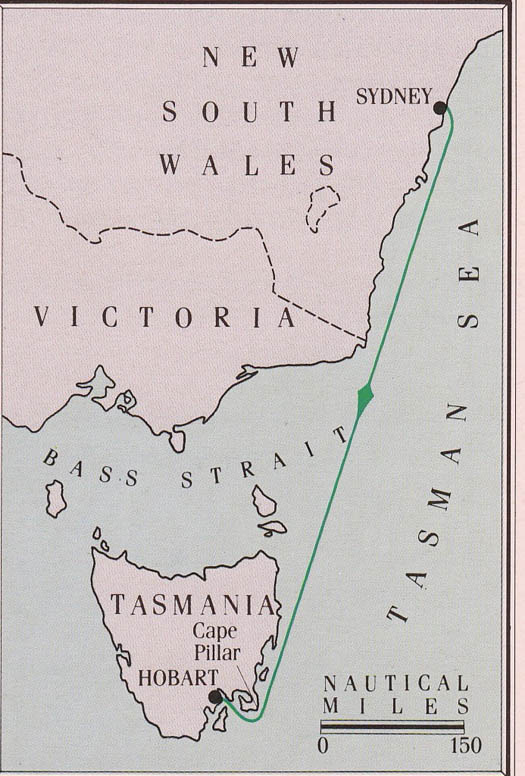
Seen in the context of the Southern Ocean, the Sydney-Hobart course may look relatively sheltered, but it has served up some very rough sailing in its 69 years.
Wild Oats will be defending both the Tattersall's Cup for the handicap win in 2012, and her 2012 course record of 1 day 18 hours 40 minutes and 20 seconds, an average of 14.7 knots. But in the way of Australian sailing these days, those who would topple her provide a formidable lineup. The dark horse in every way is Anthony Bell's 100ft Perpetual LOYAL. With her black hull and black sails, it takes an effort to realise this is Rambler 100 re-born. For when we in Ireland knew this boat back in August 2011, she was very white and very upside-down, having snapped her canting keel at the Fastnet Rock.

Black sails, black hull – Anthony Bell's dark horse Perpetual LOYAL was previously the all-white Rambler 100. She is seen here between Wild Oats XI and the Volvo 70 Giacomo (formerly Groupama) from New Zealand in the Solas Big Boat Challenge in Sydney Harbour on December 10th.
But now this JK design, still reckoned the potentially fastest hundred footer in the world, has had a complete re-vamp by original builders Cookson in New Zealand, and her former existences as Speedboat and then Rambler 100 have been airbrushed out of the picture. She's as good as new or even better, and she's keen to trot, with superstar Tom Slingsby included in her crew to Hobart.
Also competing in the elite hundred foot division is Syd Fischer's Ragamuffin 100. The legendary Fischer is 86, he's doing his 45th Sydney-Hobart, and his boat comes with quite a pedigree. Originally she was the 98ft Maximus, and New Zealand-owned. Some years back, she was in the Solent for Cowes Week under the command of Harold Cudmore. One morning there was a fine north wind, and Cudmore roused out his crew. He reckoned the fresh to strong northerly – a surprisingly rare wind in the Solent – offered the best chance at the Round Isle of Wight record. In those days, round the island record breakers – usually multi-hulls – knew they were in business if they left after breakfast and were back from the 50-mile circuit in time for lunch. The Cudmore-Maximus combo left after breakfast, and were back in time for morning coffee.
Fourth of the flat-out-racing hundred footers is Grant Wharington's Wild Thing, another former 98-footer which woke up one morning to find she'd become a hundred. She's been around the block a bit – it was ten years ago when she took line honours in the Hobart Race – and her skipper is no stranger to sailing controversy. But no-one could accuse him of lacking enthusiasm.
The fifth hundred footer edges towards the cruiser-racer end of the spectrum. German-owned by Gerhard Ruether, and Cyprus-registered, the Bruce Farr-designed Zefiro is fitting in the Hobart Race as part of a world cruise, but the word is that she's a wolf in sheep's clothing, able for 13 knots to windward in heavy weather.
However, with some forecasts suggesting a record-breaking offwind sprint, heavy weather windward ability may well count for little. But in any case, public interest is with the Wild Oats/Perpetual LOYAL contest, as the two boats are distinctly different, with Wild Oats significantly slimmer in beam. She's very much the people's choice, for though today's Australians may be enjoying unprecedented affluence, it's not so long since they were a determinedly self-reliant, can do, and DIY sort of nation.
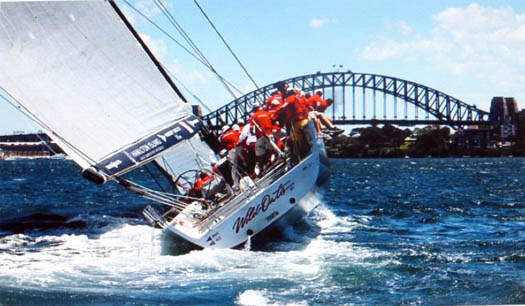
The slim hulled Wild Oats XI powering along towards the Harbour Bridge.
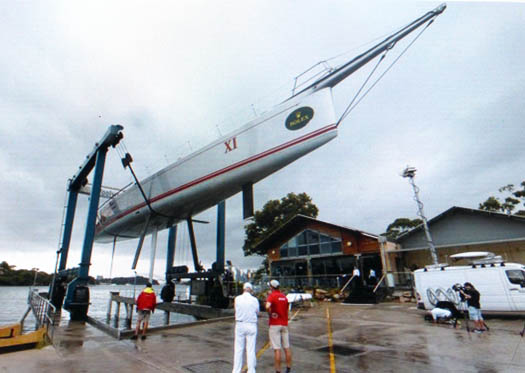
Wild Oats is always Work in Progress. Her crew reckon her latest underwater configuration has all the look of a Swiss army knife.
So the fact that Wild Oats is always Work In Progress, with mods being tried all the time, particularly appeals to the traditional Australian outlook on life, and for 2013's race she is sailing with all sorts of performance-enhancing retractable fins which make her look like a Swiss army knife when she's in the boat hoist.
With Perpetual LOYAL put into action in her new guise only as recently as November, there have been few opportunities to see how the two star biggies perform against each other. The Solas Big Boat Challenge on Sydney Harbour ten days ago was entertaining, but even Sydney's extensive natural harbour doesn't really provide the space for hundred footers to give of their best. In fact, it was Peter Harburg's up-graded Volvo 70 Black Jack (she's the former Telefonica) which led the fleet, hundred footers and all, to the first mark, which shows that she's very much a contender to Hobart.
As for the tussle between Wild Oats and Perpetual LOYAL, it looked fantastic, and Oats had got just ahead again after the more powerful yet slightly lower-rated Perpetual had passed her on the beat. But it ceased to be a tussle when Perpetual shredded a huge gennaker ($170,000 to you, sir) which, as Anthony Bell admitted, was much bigger than they should have been carrying anyway, but that's what happens when you're showing off in harbour.
Not surprisingly, it was the smaller "big boats" which scored best on IRC in the restricted space, with the win being taken by Rob Hanna's TP52 Shogun V by 1 minute and 34 seconds from Matt Allen's new 60ft Ichi Ban. But as Shogun is currently in inshore mode and is not racing to Hobart, the winner among the Hobart contenders was Ichi Ban. And that is all good news in Ireland, as she is helmed by our own Gordon Maguire, Afloat.ie Sailor of the Month for January 2013 after he'd skippered Stephen Ainsworth's 63ft Loki to overall victory in the Australian Offshore Championship.

Gordon Maguire
Everything about Ichi Ban is interesting. Her owner Matt Allen is a pillar of the Australian sailing establishment, as he's a former Commodore of the Hobart race organisers, the Cruising Yacht Club of Australia, and is current President of Yachting Australia. But if that gives you a vision of an elderly alickadoo in a blazer, forget it, the man is a bundle of energy with remarkable international connections. He is much involved with the Premier Composites facility in Dubai where the new boat was built by a team headed by Neil Cox, while the design is by Shaun Carkeek of Cape Town.

Will she be on target? Shaun Carkeek's design for Matt Allen's new 60ft Ichi Ban was aimed at meeting the Sydney-Hobart race's special requirements as averaged over many races
The Ichi Ban team selected a 60-footer, as they reckon that the numbers over the years indicate that's the optimum size for the Hobart race. But as the Solas challenge showed, it also does very nicely for shorter stuff while avoiding the huge expenditure of bigger boats.
There's no lack of bigger craft in the race to Hobart, and here there's further Irish interest, as the eight boats in the Clipper Challenge are involved for the first time, taking on the Rolex Sydney Hobart Race as part of their 17 stage round the world venture, which gets to Derry/Londonderry at the end of June.
It's a stroke of genius on the part of Robin Knox-Johnston and his team, as it puts their Clipper series right into the middle of mainstream sailing. Times was when sailors and sports writers were a bit sniffy about the Clipper project. In fact, one newspaper sports editor dismissed it as a sporting challenge equivalent to racing a fleet of tourist buses filled with paying passengers from Dublin to Killarney.
Personally, I reckon racing tour buses down the Killarney road would be very sporting indeed, but never mind. As it is, with every determined staging of the Clipper Challenge, it has risen in stature. Out in Australia, they think very highly of it indeed, and now with our own Sean McCarter of Lough Swilly YC skippering the home team's boat Derry-Londonderry-Doire (or DLDD for short) interest here is rising all the time.
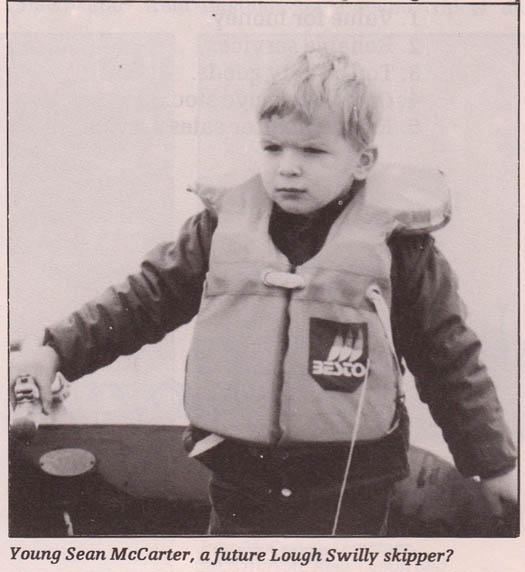
Clipper skipper Sean McCarter as he was aged four, and already at the helm in Lough Swilly in 1984

Sean McCarter in command of Derry-Londonderry-Doire during the current Clipper Race series round the world. Photo: Clodagh Whelan
Sean is 31, but he first featured in the pages of Afloat when he was a very junior helm of four years old in a 1984 feature we did about Lough Swilly. He seems to have been sailing pretty much continuously ever since, and has built up a very loyal crew following among those who have sailed on Derry-Londonderry-Doire, particularly impressing with his capable leadership when, after a knockdown on the very stormy leg from Cape Town to Albany in southwest Australia, they'd to divert to Port Elizabeth in South Africa with injured crewmembers
But then they pressed on for Albany, a port even more appreciated than most when they reached it. It was quite a party, as DLDD's Irish crewmembers include Conor O'Byrne, the Guard who is going all the way round, and Clodagh Whelan of Poolbeg Y & BC, who has rewarded herself with three Clipper ocean stages in celebration of a significant birthday landmark. It's a significant birthday for sure, but the sailing experience has to be quite something to make it special, for since she took up sailing twelve years ago, Clodagh has managed a minimum of a thousand offshore miles every year, including three round Irelands and three Dun Laoghaire-Dingles. Her current berth out of Poolbeg is on Eamon Flanagan's db34 Decibel, but Decibel will have to wait for her crewing services until July 2014, as she will be re-joining DLDD for June's Transatlantic leg to Ireland.
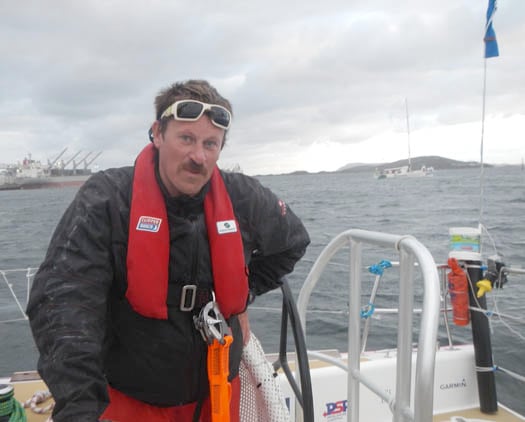
"We're here". Conor O'Byrne tired but very happy as DLDD reaches Albany after the event-filled passage from Cape Town. The moustache was grown for Movember. Photo: Clodagh Whelan

Clodagh Whelan aboard DLDD. In 2013, she fulfilled her personal objective of a minimum of a thousand offshore miles per year several times over.
Meanwhile, like all the other 93 crews from boats large and small racing to Hobart in less than five days time, for those on DLDD it will have to be the quietest Christmas they've ever had, as this can be one very unforgiving experience for anyone who has overindulged. Then too, the challenge of getting out of the harbour and into open water unscathed can be quite enough in itself, as tensions are high and the adrenalin is pumping overtime.
With a fleet of 94 boats and the handicap trophy of the Tattersall's Cup the premier award, in theory it could be anyone's race. But with five days to go, it currently has the look of a big boat's race, as the biggies may get to Hobart with the fair wind all the way. That said, the Solas Challenge showed that racing the big boats up to their optimum level is hugely challenging, whereas the two very potent Volvo 70s Black Jack and Giacomo seem totally manageable by comparison, and astonishingly fast.
And then, just slightly further down the size scale, there's the new Ichi Ban, full of potential, but still new. Extremely new. As Gordon Maguire reported in typically under-stated style on 17th December in an update to the folks back home: ".....we have been super busy, working seven days a week to get the boat ready for Sydney to Hobart. It's coming together very nicely....."
Rambler We Hardly Know You....
Last time the Irish maritime community were paying full attention to the super-maxi Rambler 100, she was white all over, she'd no keel, and she was upside down after her capsize near the Fastnet Rock during the race of 2011 writes WM Nixon.
Now she's sailing again in full racing trim. But Rambler, we hardly know you. You're right way up. Your canting keel is presumably very securely in place. And you're black, black, BLACK.
The new campaigner who has undertaken the massive refurbishment – if that's the right word – is Australian owner-skipper Anthony Bell. The restoration was done in New Zealand, where the big Juan K-designed machine was built by Cookson's in the first place, but everything about the boat's current career will be Australian-centred.
Her official launch earlier this month was performed by the Oz Prime Minister Tony Abbott, and the boat is now Perpetual LOYAL in a sponsorship linkup between two leading Australian brands. And of course the Sydney-Hobart Race on December 26th will be the debut par excellence, for despite being around for quite a few years now, even while being constantly up-dated the big lady has never done the dash to Tasmania.
So naturally the battle for line honours between current record-holder, the 100ft Wild Oat XI (owned by 35th America's Cup Challenger of Record Bob Oatley) and Perpetual Loyal is going to grab the headlines. But Wild Oats' current up-grade programme suffered a recent serious setback with the "catastrophic failure" of a new large lighter mast.
However, for Perpetual LOYAL aka Rambler Re-born, it's all systems go. Although Anthony Bell is himself has a CV of three Hobart races, he has signed on 29-races veteran Michael Coxon as sailing master, legendary American techno-ace Stan Honey is navigator, and the afterguard includes Olympic Gold Medallist and America's Cup superstar Tom Slingsby.
With entries looking to surge comfortably over the hundred mark, it has all the makings of a vintage Sydeny-Hobart, as there'll be a particularly good turnout among the biggies. Further down the fleet, Irish interest will also focus on the boats of the Round-the-World Clipper Fleet, taking part in the Hobart race for the first time. This a good move as it makes the Knox-Johnston project much more part of mainstream sailing, and the man himself will be navigating a former clipper boat in the race too.
But each Hobart race proves to be very much a case of horses for course, and over the years former CYCA Commodore Matt Allen (a veteran of 23 races) has concluded that a potent 60 footer offers the best all-round chance for the Tattersall's Cup, the prized troiphy for the overall handicap win. His new Carkeek 60 Ichi Ban is barely out of the wrappers after arriving from the Matt Allen-owned building facility in Dubai. With the looks of an up-dated and enlarged TP52, and current Australian champion offshore skipper Gordon Maguire on the helm, Ichi Ban might well be worth a flutter over Christmas.
Five Super Maxis in Fleet of 97 Signed On For 2013 Rolex Sydney Hobart
#sydneyhobart – One year out from the 70th anniversary race, the Cruising Yacht Club of Australia announce that 97 entries have been received for the 2013 Rolex Sydney Hobart Yacht race, including five super maxis, 22 international entries, 15 new boats, 36 first timers, previous overall and line honours winners and the many supportive regulars, the 'meat' of the fleet.
At the pointy end of the fleet, one of the most compelling in years, is defending triple crown holder Wild Oats XI (Bob Oatley) taking on what is allegedly the fastest racing super maxi in the world, Loyal (Anthony Bell). It is purported the former Speedboat/Rambler is capable of making 45 knots downwind.
That knowledge alone will have Wild Oats XI skipper Mark Richards and his crew working even harder than ever, as they did when George David was ready to head this way for the 2011 race when he owned Rambler. Then its keel snapped off in the 2011 Rolex Fastnet Race.
There are 22 international entries, a record of sorts. The 50th anniversary race in 1994 produced 25 internationals from its 371 entries. During the 1970's and '80's, the numbers came close in the odd numbered years when the Southern Cross Cup was in vogue and fleet numbers were well over 100.
This time, boats from New Zealand, United Kingdom, Hong Kong, Singapore, New Caledonia, Germany and Cyprus will take their places on the start line.
With so many unknown quantities in the race this year, because of new boats, those trading up to other yachts and first timers, favourite contenders for the overall win is in the lap of the gods, but there are some regulars whose form is good.
Previous overall winners up for the challenge include Kim Jaggar/Travis Read's Illusion (1988), Roger Hickman's Wild Rose (1993), James Cameron's Luna Sea (as AFR Midnight Rambler in 1998), Philip Child's Knee Deep (as Yendys in 1999) and John Newbold's Primitive Cool (as Secret Mens Business 3.5 in 2010).
The final fleet for this year's Rolex Sydney Hobart will be announced at the CYCA on the morning of Tuesday 26 November, 2013
Another Plunge for Maguire in Hobart?
#sydneyhobart – Christmas partying is on hold for top ex-Pat sailor Gordon Maguire as he and his crew make the final preparations to defend their place as champions in the premier offshore event in the Southern Hemisphere, the annual Rolex Sydney-Hobart Race.
Since its inauguration in 1945, the 628 mile classic to Tasmania across the challenging Bass Strait has started every year on St Stephens Day. However, in the early events, going off on the thrash to Hobart was considered an integral part of the Christmas festivities – it wasn't unknown for crews to be still partying even as they raced down Sydney Harbour towards open water.
But these days, with an elite lineup next Wednesday of some of the greatest offshore racing boats in the world, it is incumbent on all crews to be hyper-fit and well able for anything the sea can throw at them. If you're not - as has been shown in some of the storm-battered stagings of this great race - the result could be fatalities.
The worst storm of all came in the 1998 race, and the helicopter vids of that would test the offshore racing enthusiasm of even the keenest hardcase viewer. It's quite something to witness 80ft plus Maxis racing along like over-pressed dinghies out in the open water of the Bass Strait. But when you see one of these biggies leap out of the top of a wave and crash into the sea beyond with the huge rig shuddering like a leaf, then you get some idea of what the Sydney-Hobart mystique is all about.
For anyone prone to seasickness, Christmas dinner the day before might be no more than boiled whitefish and mashed potatoes. And out there in the bash southward down the coast of New South Wales, it's a rough world in every sense, with sympathy is in short supply. Last year one of the participants was the famous American vintage 48-footer Carina, built 1969. Having won the 2010 Bermuda Race, she then won her class in the 2011 Fastnet Race and placed fifth overall, an extraordinary achivement. So then the junior members of the crew simply sailed her out to Sydney straight across the Atlantic and the Pacific in time for the 2011 Hobart Race. When the senior crew members joined up, they hadn't been offshore since the Fastnet, and weren't as battle-hardened as the young toughs. So on the second night, slugging into a southerly buster, some very distinguished American yachtsmen were not at all well. Sympathy? No chance. The heartless young Turks simply let the world know that "The Roar of the Dinosaur was Heard Across the Valley of the Lee Rail..... "
For Gordon Maguire and the crew of the 63ft Loki, as defending champions they've everything to lose next week. But the boat is in top form – they lead the points table in the current Australian offshore championship - and with Maguire as sailing master, owner Stephen Ainsworth has one very special talent.
When Loki won the race last year, it was Ainsworth's 14th attempt. But Gordon Maguire won at his very first shot, back in 1991 when he was helming, with Harold Cudmore as boat captain, aboard the 41ft Atara. She was part of the three boat Irish team that stormed Australian sailing to win the Southern Cross series, which culminated in the Hobart race where the Cudmore/Maguire victory sealed the team win.
For next Wednesday's start, the forecast is for fresh sou'easterlies initially, then going east and even northeast before a new westerly sets in late Friday. With plenty of wind expected in the mixture, this pattern suggests that one of the hundred footers – there are four of them in the race – might get to Hobart in a new record time.
As all the biggies are owned and sailed by tough cookies sent out by Central Casting to be the very personification of over-the-top Australian exuberance, the battle of the giants for line honours inevitably draws the initial headlines, and it has added Irish interest as Offaly-born Adrienne Cahalan is navigator (her 21st Sydney-Hobart) on one of the most fancied hundred footers, Wild Oats. But the Tattersall Cup for the overall IRC victor is one of Australia's most revered sporting trophies, and as the big boat brouhaha settles, all attention in Hobart will focus on who is coming up the Derwent towards the finish with a chance of snatching the lead.
When Loki was confirmed as overall winner by 50 minutes in the last days of 2011, the real party started, and Gordon Maguire was ceremonially thrown into the harbour. He didn't mind that at all. He soon texted the folks at home to tell them that the water in Hobart was nowhere near as cold as the water up at Lambay had been back in August 2011, when he'd to go over the side to clear a lobster pot line from the propellers of his father Neville's motor-cruiser.
MORE CLASSIC BOATS FROM PORTRUSH
Our story last week about the Howth 17 Deilginis, built by James Kelly of Portrush in 1907 and restored this year with a new deck by Rui Ferreira of Ballydehob, has rung the bell for classic boat enthusiasts. That fine north coast sailor Robin Ruddock (who restored Wallace Clark's 36ft yawl Wild Goose after she'd suffered the indignity of spending a month under water at the mouth of the River Bann) plays a key role in keeping the Kelly memory alive, for there's no boat building at all these day in Portrush.
But when he was at his busiest, between the 1890s and the 1930s, James Kelly made Portrush a remarkable centre for the master shipwright's art and craft. Initially, he set out to build Drontheims. those elegant double-ended clinker-built 26 footers which were derived from boats imported from the Norwegian port of Trondheim, and were developed along the north coast as multi-purpose vessels. As most of them were built at Greencastle in Donegal, they became known as the Greencastle yawls, but other builders right along the north coast produced their own local variants, and James Kelly was so good at it that he soon had Portrush rivalling Greencastle as a boat-building centre.
But his reputation soon spread beyond the Drontheims, and during the 1890s he started building yachts, two of the most noted being the 9-tonner Saiph in 1897, and the 15-tonner Yucca in 1898. They were both designed by their owner, Howard Sinclair, a Belfast doctor who was an early cruising pioneer – in 1896 he was the first winner of the Challenge Cup of the Cruising Club (later the Royal Cruising Club) for a round Ireland venture with his 5-tonner Brenda, built by Hilditch of Carrickfergus. He was awarded the cup again in both 1896 and '97, for cruises to the Outer Hebrides and the Orkneys with Saiph and Yucca.
James Kelly cheerfully admitted that there was much better money in yacht building than in the construction of fishing boats, but he kept the fishing boat side of his business going, albeit on the back burner. By the early 1900s, however, he was right up there with the leading yacht builders in Ireland, and two of the new Dublin Bay 21s came out of the Kelly yard in 1903-04, Garavoge and Oola.
Thanks to Hugh McGrattan of Portrush, we have this eloquent photo of Garavoge just before her launch in 1903. There is an entire universe in this portrait of the elegant yacht and the crowd about her, with the owner and his friends, and the rightly proud workforce and their friends, all basking in the goodwill at the height of the Edwardian era. And the new Mylne-designed boat looks marvellous – if anyone ever asks you what a classic counter stern should really look like, you couldn't do better than this.
In her long career, one of Garavoge's owners was Gordon Campbell, Lord Glenavy – he was a real mover and shaker in Dublin Bay sailing as he was also active in the Water Wags and the Mermaids, and in 1934 it was his suggestion which led eventually to the Dublin Bay 24 class.
His son was Patrick Campbell the humorist and TV personality, who wrote of sailing in Garavoge – his account of returning from Wicklow Regatta in fog is a gem. When he was told in 1978 that the Twenty-Ones were still active and that Garavoge was still with them, he expressed surprise, saying he thought that by that time "the better bits of Garavaoge would have long since been turned into a dog kennel, or at the most optimistic level, a sturdy home for hens".
With the remains of the seven boats of the Dublin Bay Twenty-One class now mouldering in a farmyard in County Wicklow, Campbell's drollery has become all too true. After he'd seen the photo last week of the Kelly-built 1907 classic Deiliginis so beautifully restored, Robin Ruddock asked what had become of Garavoge. It would have been too cruel to tell him.
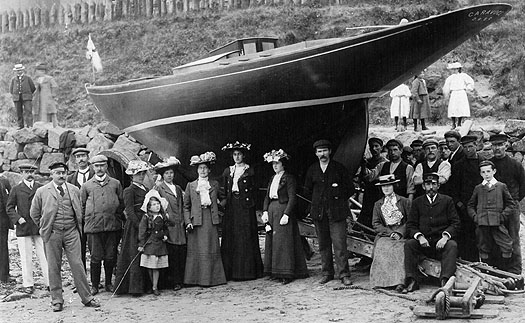
Launching day for the Dublin Bay Twenty-One Garavoge at Portrush in 1903. The builder James Kelly is believed to be beside the rudder. Photo courtesy Hugh McGrattan
THE YACHT DESIGNER IN THE CELLAR
My appreciation here a fortnight ago of the late Mike Balmforth and his remarkable career in many branches of the marine industry has started a line of chat in some nautical forums about the T24, T27 and T31. It was one of Mike's first jobs in the boat business, building these performance cruisers with Chris Perfect in Chichester, and mention of the marque has revealed a network of Guy Thomson fans.
Guy Thompson was a leading East Anglian offshore racing enthusiast during the 1940s, 50s and 60s who worked for the Bank of England at their massive headquarters in Threadneedle Street. But he was also a very talented and innovative amateur yacht designer, so much so that a succession of boats he designed for himself – all called Calliope – were always in the EAORA prize list. Thus it's perhaps not strictly true to say that he worked for the Bank of England. He was employed by them. But his real work was down in the cellars, in an unused room he discovered which, over the years, he turned into a proper little secret yacht design office.
We shouldn't be surprised by this – after all, Kenneth Grahame, for many years the Secretary of the Bank of England, also found the time to write the children's classic The Wind in the Willows.
Nevertheless, Guy Thompson's parallel career as a part-time yacht designer was in a league of its own, and when he retired from the Bank, he left behind this secret room stacked to the ceilings with yacht designs and drawings.
Maybe he was too much of a free-thinker to have functioned as a professional designer. As it was, his unique position allowed him to be way ahead of the posse, and in the 1960s when noted East Anglian dinghy racer Dick Pitcher (he was an ace in the Flyng Dutchman) decided he wanted a small performance cruiser, he went to Guy Thompson.
Pitcher's specification was for five berths, full standing headroom, excellent all round performance, and all within 24ft LOA. The result was a little boat called Goosander with which Pitcher won everything about him in 1967, and soon the production version, the T24, was on sale.
As the plans show, there was so much good sense and innovative thinking in the T24 that it's a pity Guy Thompson wasn't designing full time – many yacht designs at this period were dull and unimaginative in the extreme. But the T24 hit the button for those who could think outside the box, and one of the first in Ireland was Kilderkin for Lance McMullen of Dun Laoghaire. His previous boat had been the 36ft ex-6 Metre Rainbow, yet his new much smaller boat was an improvement in almost every way.
Sadly, in the 1960s some of the new GRP production boats were built with wooden decks and coachroofs on the fiberglass hull, and the T24 was one of them. It didn't take long before the clashing behavioural characteristics of the two materials caused problems, and a later owner of Kilderkin recalls her as leaking along much of the hull/deck join.
But like all T24 owners, he fondly recalls her gallant performance, particularly to windward in a breeze. When you think of what some of the boring standard boats of the 1960s were like, you can appreciate why the astonishing little T24 was like a breath of fresh air. And our friends on the forum assure us that a reasonably able amateur handyman with time available can fix those deck leaks.

The boat designed in a cellar in the Bank of England. Guy Thompson's T 24 had the accommodation and performance of many boats half as big again. And don't forget if someone is taking a photo of your boat, always sit down - otherwise she'll look even smaller than she is already
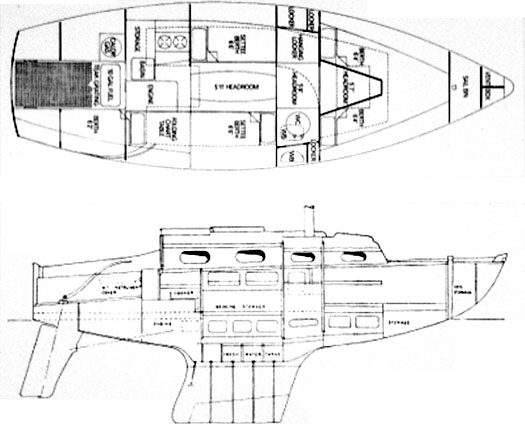
If you want to see how five berths, full standing headroom and a scintillating performance can be fitted into a hull just 24ft LOA, take the time to study these plans of the T24.
Gordon Maguire Lifts Sydney-Hobart Trophy
#SYDNEYHOBART – Dublin Sailor Gordon Maguire won the Rolex Sydney-Hobart Race, a high point in his career as a leading international professional sailor based in Australia writes W M Nixon in the Irish Independent.
Twenty years ago, the young Howth helmsman was one of the key players in the Irish team which won the Southern Cross Trophy, the international offshore series which culminated in the Hobart Race.
For someone with Maguire's remarkable talents, Australia offered the perfect arena and base, and he increasingly focused on the active scene down under. But he also continues to sail worldwide, his most recent high profile appearance in Ireland being three years ago when he was lead helm on Mike Slade's 100ft Leopard establishing the course record in the Round Ireland Race.
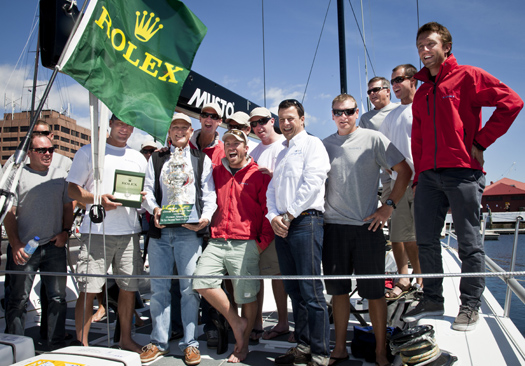
The winning Loki crew included Howth's Gordon Maguire. Photo: Daniel Forster/Rolex
Since then, his career path has been as sailing master with Stephen Ainsworth's Australian team. Ainsworth acquired some note in Europe back in 2007 when his mini-maxi Loki, powering along in the stormiest Middle Sea Race yet experienced, broke the rudder and became a total loss on the northwest coast of Sicily. That iron shore would rank high on any world listing of least desirable places to be shipwrecked, and some advanced yacht racing equipment subsequently turned up in unlikely mountain sales.
But at least no-one was hurt. And a new Loki, a 63ft Reichel Pugh design, was already on the drawing board. To get the best from the new boat, Ainsworth and his ace navigator Michael Bellingham signed Gordon Maguire (48) onto what became a dream team. Since 2008, Loki has won just about everything of significance in the Australian eastern seaboard offshore racing scene except the annual thrash to Hobart, which Ainsworth has been trying to win for more than a dozen years.

The winning mini-Maxi Loki. Photo: Daniel Forster/Rolex
The 628-mile classic – staged annually since 1945 – can be a tricky one. You go like the hammers of hell on rough ocean for upwards of 550 miles, and then the final approach to Hobart up the narrowing 60-mile ria of the Derwent River sees the winds all over the place, and often non-existent at night.
The new Loki (named for the Norse god of mischief and trickery) invariably finished among the leaders, but then saw her corrected time win for the Tattersall's Cup – Australia's premier offshore trophy – being snatched away by some smaller boat which came creaming up the Derwent on the afternoon breeze.
But Ainsworth and Maguire have been very close to the cup for the last two years, and this year they struck gold. It was the turn of the smaller boats to be becalmed in the small hours. After hours of the clock ticking painfully slow, Loki was declared winner of the Tattersall's Cup. The biggest box of all had been firmly ticked in gold.
Line Honours Decided, Who Will Be Sydney-Hobart's Overall Winner?
#SYDNEYHOBART – With the line honours podium decided in the Rolex Sydney Hobart Yacht Race, focus now shifts to the handicap race under IRC for the Tattersall's Cup.
The closest finish in the last 29 years of the Rolex Sydney Hobart Yacht Race took place when Anthony Bell’s maxi Investec Loyal fended off repeated challenges from Bob Oatley’s perennial line honours victor Wild Oats XIto win by just 3 minutes and 8 seconds, after 2 days 6 hours 14 minutes and 8 seconds of racing on this classic 628 mile course.
The competition for line honours in this race was one of the closest in its 67 year history with the two Australian maxis gunning for each other from the moment the canon was fired on Sydney Harbour on Monday afternoon. Wild Oats XI led until 20:00 local time (09:00 UTC) on Tuesday when they were becalmed.
Stephen Ainsworth's crew on the successful Reichel Pugh 63 Loki is hoping that their corrected time in the race, that currently has them second under IRC, will elevate them to first place. This would give Ainsworth, who earlier this month was crowned the Cruising Yacht Club of Australia's 2011 Ocean Racer of the Year, the handicap win in the Rolex Sydney Hobart that has so far eluded him.
Assuming the crew on the current IRC leader, Roger Hickman's Farr 43 Wild Rose, continue to sail as well as they have to date in this race, then it will take a down turn in conditions for them to be toppled.
This afternoon Hickman's 1993 Rolex Sydney Hobart Race winner had just under 100 miles to go to the finish.
From on board Jennifer Wells reported: "We've been up with the leaders most of the time. At approximately 2.30pm we were 75 nautical miles from the Tasman Light in fluky winds. It's been fabulous sailing down the east coast of Tasmania, but we're hoping we'll get better breeze. We're ecstatic to be able to do so well in such an old boat' that won the race in 1993.
"It was wet and rough the first night, especially off Pambula. It was quite easy coming across Bass Strait – easier than sailing down the south coast."
Of her skipper, Roger Hickman, currently sailing his 35th Rolex Sydney Hobart, Wells said: "It's a benevolent dictatorship. The crew are very excited to sail on what was the original Wild Oats."
However an area of high pressure is moving over the race area, bringing sunshine to the spectators turning out in Hobart, but also a drop in wind strength off the east coast of Tasmania. While Wild Rose has a little in the bank in terms of her lead, we will have to wait until tomorrow to find out if Hickman can achieve his second win.
Latest arrivals
Meanwhile more boats have arrived in Hobart, the latest being Jim Cooney's former line honours winner, Brindabella, home in 12th place on the water. Ahead of the classic 1990s maxi there has been a major showdown between the Rolex Sydney Hobart's competitive fleet of 50 footers.
Home in 11th place, 16 minutes before Brindabella was Robert Date's Reichel Pugh 52, Scarlet Runner.
"We started off very well up until the time the sun went down on the first night, but we had a problem where we lost all our instruments, so we had to sail like blokes used to about 50 years ago with dead reckoning and a sextant!" said Date, adding that because of this they had lost around 15-20 miles on the competition and this they were unable to regain.
However this was not the end of their problems and at one stage Date said they were lucky not to dismast. "We lost one of the lower diagonal stays when the pin that holds it in came out. One of the crew managed to spot it and we grabbed it and changed on to the opposite tack and put that all back together. If we hadn't spotted that in time we would have lost the mast."
Aside from the boat Date admitted that he had also had a few issues of his own during the race, suffering a fall in the cockpit and on one occasion when the bunk he was in, on the weather side, gave way and he was propelled down to the leeward side of the boat.
Jason Van der Slot and John Williams' Victorian crew on the modified TP52 Calm (formerly Stuart Robinson's Stay Calm) were the first of the TP52s home, arriving in Hobart 11 minutes ahead of Chris Bull's Cookson 50 Jazz, to take eighth place on the water.
They too had rigging issues. "We had a D1 pop out after Gabo on the first morning," said Van der Slot. "We lost about six hours just making sure the rig was okay. From there we pumped the boat pretty hard and we managed to get in front of Ragamuffin and Jazz and we caught them up the river. We were eighth across the line but they might have got us on IRC. We are happy with how the boat performed – it was a good event."
Van der Slot said that they had managed to regain lost ground on the Derwent river on the approach to Hobart thanks to local knowledge – he was born and bred here.
"The 50ft competition was amazing. Every time we tacked and gybed and crossed paths, it would be Ragamuffin there. I think we finished where we thought we would with the preparation we put in. We are a bit disappointed under IRC. We put a pretty hard campaign for this together nine months ago and we have got some good key people on board for this race. We are happy with where we finished up."



























